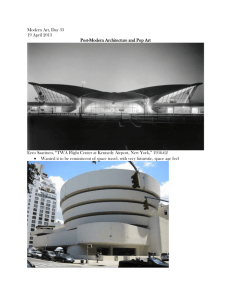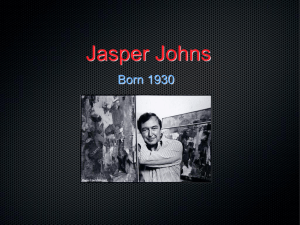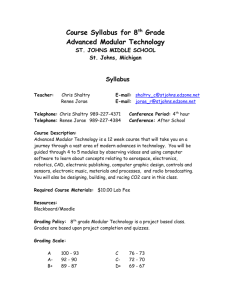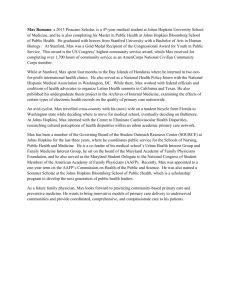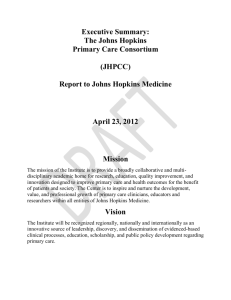exhibition label copy
advertisement
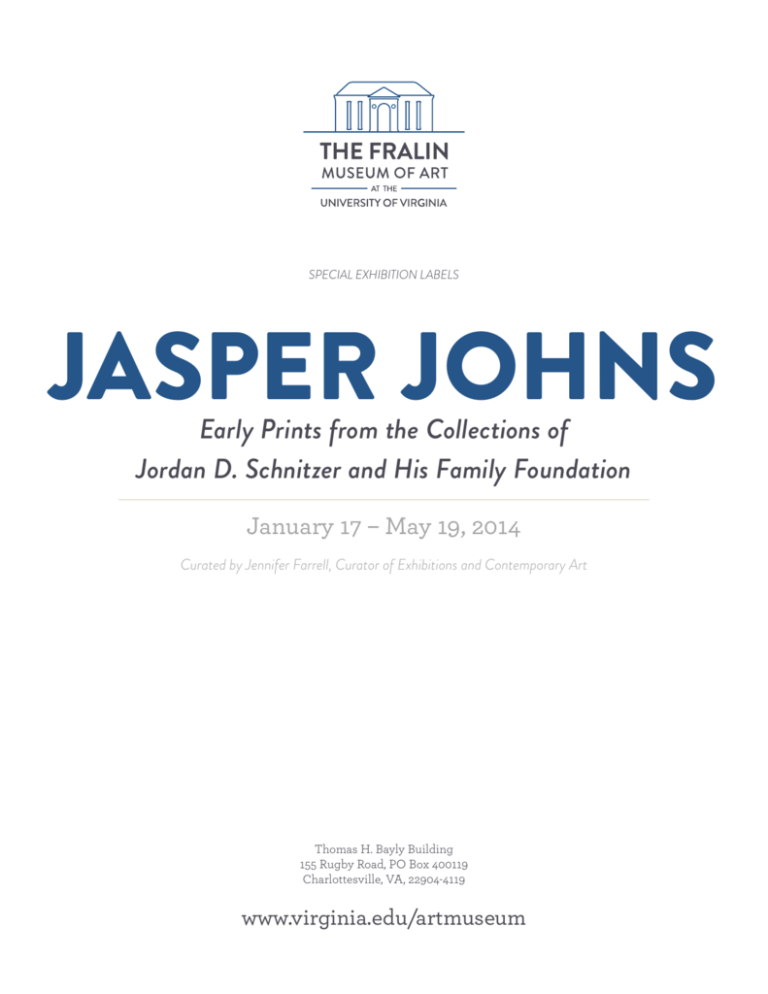
SPECIAL EXHIBITION LABELS JASPER JOHNS Early Prints from the Collections of Jordan D. Schnitzer and His Family Foundation January 17 – May 19, 2014 Curated by Jennifer Farrell, Curator of Exhibitions and Contemporary Art Thomas H. Bayly Building 155 Rugby Road, PO Box 400119 Charlottesville, VA, 22904-4119 www.virginia.edu/artmuseum Introduction Since the mid-1950s, Jasper Johns (b. 1930) has fundamentally challenged ideas about what art can be by focusing on everyday icons and emblems, or what the artist famously referred to as “things the mind already knows.” While perhaps best known for his paintings, Johns is also widely respected for his graphic work, which has occupied a central role in his oeuvre for over five decades. Johns’ prints not only show a mastery of the various media with which he has engaged, but also a profound sense of experimentation. Printmaking has allowed him to explore methods for interpreting icons, emblems, and objects—such as numbers, letters, maps, targets, and ale cans—while also expanding the possibilities for the medium. Several of his prints make reference to the artist’s work in other media, yet they are not mere copies or reproductions. Rather, Johns addresses modes of perception and, by extension, ways of knowing. The processes of printmaking allow him to explore the impact of various methods and techniques on the image—what he has referred to as “differences and samenesses”—made visible in each context. Prints have also influenced Johns’ work in other media; in the early 1960s he began incorporating printmaking techniques and materials in his paintings and, by 1971, images that had first appeared in prints. In this way, Johns’ practice reflects a note found in one of his early sketchbooks: “One thing used one way/Another thing used another way/One thing used different ways at different times.” This exhibition comprises selections from the Jordan D. Schnitzer Family Foundation, one of the most respected and comprehensive private collections of contemporary prints. Beginning with a rare monoprint from 1954, the exhibition showcases over twenty years of Johns’ work. In addition to illustrating his technical skill, the exhibition shows the quotidian and often enigmatic motifs that are central to his art. From the almost deadpan literalness in the series 0–9 (1963) to the complex layers of objects and meanings in Decoy II (1973), the exhibition reveals the skillful and poetic ways in which Johns has both consistently advanced printmaking and engaged links between seeing and knowing. The Fralin Museum of Art’s programming is made possible by the generous support of The Joseph and Robert Cornell Memorial Foundation. The exhibition is made possible through the generous support of the Suzanne Foley Endowment Fund, the Jordan Schnitzer Family Foundation, albemarle Magazine, and Ivy Publications LLC’s Charlottesville Welcome Book. Jasper Johns | 2014 2 Labels Untitled, 1954 Monoprint Collection of Jordan D. Schnitzer, 2006.420 Lead Reliefs: Numerals, 0 through 9, 1969 (published), 1970 (signed) Lead relief with polystyrene and wood backing in an aluminum frame, edition 13/60 Collection of Jordan D. Schnitzer, 2005.277 0–9, 1963 Portfolio of ten lithographs, edition B/C 3/3 AP Collection of Jordan D. Schnitzer, 2006.107a – 107j In 1960, Johns received a lithographic stone from the publisher Tatyana Grosman who hoped to entice him to make prints at Universal Limited Art Editions (ULAE), her publishing company. Johns, new to the medium, drew a zero on the stone, as it was symmetrical, easy to make, and did not require that the image be drawn in reverse. He later added the frieze of numbers above the larger figure, a decision that inspired the series 0–9, one of the most technically challenging works made in recent lithography. Because Johns printed the lithographs on the same stone, reworking them for each large numeral, elements from previously printed numbers remain faintly visible throughout the progression. The stenciled form and the predetermined order found in both the frieze and the large numbers create a sense of continuity within the series, yet Johns also endowed each large number with distinct visual qualities to distinguish each form and counter the banality associated with the subject matter and the stenciled letters. By rendering numbers as abstract symbols, even arrangements of color and form, Johns challenged the more functional associations evoked by them and, by connection, systems of knowledge. Johns created three editions—“A/C,” “B/C,” and “C/C”— of the 0–9 prints. Prints in “A/C” were made with black ink on handmade ivory paper, “B/C” with gray ink on handmade unbleached paper, and “C/C” with colored ink on handmade white paper. Johns originally conceived of the series in tones of gray, such as the prints on display in this gallery. His link to the combination of gray ink and unbleached paper, which would approximate the color of the lithographic stone on which he worked, is shown through the early date—“60”—inscribed on a print from the “B/C” edition, while prints in other editions were signed “63.” Jasper Johns | 2014 3 Numbers, 1967 Lithograph, edition 30/35 Collection of Jordan D. Schnitzer, 2006.109 Gray Alphabets, 1968 Lithograph, edition 27/59 Collection of the Jordan Schnitzer Family Foundation, 2000.44 The 1956 painting of the same title was Johns’ first engagement with the alphabet and letter themes, as well as the first time he used the word gray—a reoccurring color in his oeuvre—as part of a title. Made at the studio of Gemini G.E.L. in Los Angeles with master printer Kenneth Tyler, Gray Alphabets required four matrices and, at the time, was the largest and one of the most ambitious lithographs Johns had created. Johns was deeply involved with its production and mixed the inks himself in order to capture tones and the sense of luminosity of the graphite wash used in the 1960 drawing of the same title and theme. In Gray Alphabets, Johns expertly plays off the tension between the all-over composition and the discrete forms of the blocks and the letters each contains. As with 0–9, each letter is simultaneously reflective of an established order—an effect amplified by the grid structure— and unique due to its variations of gray tones and marks. No, 1969 Lithograph with embossing and lead object, edition 30/80 Collection of Jordan D. Schnitzer, 2012.160 Jasper Johns | 2014 4 Coat Hanger II (Variation), 1960 Lithograph with embossing, edition AP 1/3 Collection of Jordan D. Schnitzer, 2006.85 Coat Hanger II reflects Johns’ desire to engage objects from everyday life in a deadpan, almost literal sense. The artist explored the motif of the rather humble wire coat hanger in a 1958 conté crayon drawing, a 1959 painting, and Coat Hanger I, a print made earlier in 1960. Johns likely used the same stone for Coat Hanger I and II, and, although the image in Coat Hanger I is less visible due to the darker palette and heavy marks, the composition is consistent in both prints. Coat Hanger II, however, has a greater trompe l’oeil effect, enhanced by the stark contrast between the hanger and the background, which also closely links it to the painting that incorporates an actual hanger. The art historian Leo Steinberg noted that Johns’ use of quotidian objects such as rulers, ale cans, and coat hangers not only makes reference to Dada works by artists such as Marcel Duchamp and Man Ray, but also captures “feelings of emptiness, loss, abandonment or dehumanization in this common object.” Painting with Two Balls, 1971 Screenprint, edition PP 3/4 Collection of the Jordan Schnitzer Family Foundation, 2000.66 Johns has explored the “Painting with Two Balls” theme in numerous formats: a 1960 encaustic and collage on canvas; a charcoal, pastel, and pencil drawing; lithographs (including his first multicolored print and first lithograph made with two stones in 1962); and screenprints. In this print, Johns evoked the painting through the title, which is shown in stenciled letters in the work itself, and the broad swaths of primary colors, split surface, and two small balls that appear to have created this rupture. Rather than reproduce the painting, however, Johns’ graphic works allow him to create a kind of tension between mediums, contrasting reality and illusion and both stressing and undermining properties specific to each form. In Painting with Two Balls, for instance, Johns works against the sharp edges and smooth, seamless color associated with screenprints. Drips, splotches, and stains refer to the uneven pigment of the painting, while layered scribbles connote gestural brushstrokes frozen in encaustic as well as elements of drawing. Technics and Creativity: Target, 1971 Offset lithograph and collage, edition of 22,500 Collection of the Jordan Schnitzer Family Foundation, 2003.53 Jasper Johns | 2014 5 Target with Four Faces, 1968 Screenprint, edition 89/100 Collection of Jordan D. Schnitzer, 2003.204 The target, distinguished by being both image and object, is perhaps the motif most associated with Johns. The form—five concentric circles against a flat support—made its debut in Johns’ art in the spring of 1955 with the encaustic and collage work Target with Plaster Casts. Johns has subsequently engaged the image over fifty times in various configurations and media, including over thirteen different prints reflecting a variety of techniques. In 1960, Johns’ first published lithograph was of a target, as was his first etching in 1967. Target with Four Faces, his first screenprint, makes reference to the 1955 painting of the same name. Johns has spoken about his desire to challenge the processes and characteristics of various forms of printmaking to “achieve a different kind of complexity.” In this work, for instance, Johns incorporated illusionistic effects of drawn lines and panels of simulated wood grain. In the related work Technics and Creativity: Target, Johns humorously makes reference to both the ubiquity of targets and the seemingly simplistic construction of his celebrated paintings, drawings, and prints of them. Pinion, 1966 Lithograph, edition 13/36 Collection of Jordan D. Schnitzer, 2006.108 Decoy II, 1973 Lithograph, edition PP 2/2 Collection of Jordan D. Schnitzer, 1996.15 In 1971, Johns made Decoy, one of his most complex early works on paper and the only print to inspire a painting, a reversal of his practice of creating a composition first in painting or sculpture, then in print. Decoy II responds to both the earlier lithograph and the painting made later that year. Decoy and Decoy II can be viewed as retrospectives as Johns incorporated images and icons engaged in earlier paintings, sculptures, and prints, including the Ballantine ale cans featured in the 1960 sculpture Painted Bronze and the 1975 print Ale Cans, shown in this exhibition. Names of colors, which began appearing in Johns’ works in 1959, operate more conceptually than as agents identifying what one experiences visually. Color is also evoked by the spectrum that runs along the top section of the print. A fragmented leg suspended in the upper corner, drawn from Watchman, a 1964 painting with objects, adds an uncanny element to the composition. Jasper Johns | 2014 6 Ale Cans (ULAE 154), 1975 Lithograph, edition RTP Collection of Harsch Investment Property Management, 2009.37 Like many of his contemporaries, Johns was profoundly influenced by the artist Marcel Duchamp. Several of Johns’ works make reference to Duchamp’s concept of the Readymade, that is an ordinary, mass-produced object that the artist selected, removed from its functional role, and declared to be art. One of Johns’ earliest and most celebrated works to feature such a quotidian subject was Painted Bronze, his 1960 sculpture of two cans of Ballantine ale. The ale cans, one of Johns’ most recognizable motifs, reappear throughout his work in a variety of media and over several decades, and, in each evocation, can be read as making reference to both the sculpture and actual cans of Ballantine ale. The image of the ale cans also reappears in Decoy II, featured in this exhibition, where it is in dialogue with words and images derived from earlier paintings and prints. Two Maps I, 1966 Lithograph, edition 24/30 Collection of the Jordan Schnitzer Family Foundation, 2000.45 The Critic Sees, from the portfolio Ten from Leo Castelli, 1967 Screenprint and embossing with collage and acetate, edition 110/200 Collection of Jordan D. Schnitzer, 2006.384b The Critic Sees was based on a 1964 sculpture in which images of mouths replace the eyes behind the glasses, thus conflating speaking and seeing while rendering vision—implied by the glasses—impossible. The Critic Smiles is one of only six Lead Relief pieces Johns made between 1969 and 1970 (another such work, 0–9, is also in this exhibition). In the work, a toothbrush is presented on a small shelf, below which the title of the work and the artist’s signature appears. Instead of bristles, however, there are glistening gold teeth, which give the work elements of both humor—the gold teeth imply the replacement of the natural ones and, by connection, the failure of the toothbrush—and menace. As with The Critic Sees, the titles evoke an absent body while also contradicting what is shown in the work. Both The Critic Smiles and The Critic Sees have been read as puns specific to the art world, yet the term “critic” also functions in a broader sense, applicable to the relationship between the artist and anyone who encounters his or her work. Jasper Johns | 2014 7 Lead Reliefs: The Critic Smiles, 1969 Embossed lead relief with gold and tin foil additions, edition 11/60 Collection of Jordan D. Schnitzer, 2006.374 Souvenir, 1970 Lithograph, edition 4/50 Collection of Jordan D. Schnitzer, 1998.41 Johns had earlier incorporated traces of his body in his art (for example, the imprints of his hands, feet, and knees in Pinion), yet Souvenir was the first piece to show such a direct and recognizable representation of his features. Because of this, some have read the print and the two paintings Johns made with the same title and theme in 1964 as selfportraits, particularly as they also contain allusions to his work as an artist, his frequent use of stenciled letters, and his engagement with everyday objects such as the flashlight. Yet Souvenir is more complex than a simple self-portrait. Johns plays off multiple meanings evoked by the title, which makes reference to both a literal souvenir—the ceramic plate purchased in a tourist shop in Japan—and the act of remembering that such objects are believed to prompt. These associations are heighted by the handwritten word “souvenir” scrawled across the verso of the blank canvas, which functions simultaneously as title, description, and command. Jasper Johns | 2014 8
